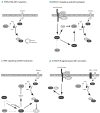The relevance of PTEN-AKT in relation to NOTCH1-directed treatment strategies in T-cell acute lymphoblastic leukemia
- PMID: 27582570
- PMCID: PMC5060017
- DOI: 10.3324/haematol.2016.146381
The relevance of PTEN-AKT in relation to NOTCH1-directed treatment strategies in T-cell acute lymphoblastic leukemia
Abstract
The tumor suppressor phosphatase and tensin homolog (PTEN) negatively regulates phosphatidylinositol 3-kinase (PI3K)-AKT signaling and is often inactivated by mutations (including deletions) in a variety of cancer types, including T-cell acute lymphoblastic leukemia. Here we review mutation-associated mechanisms that inactivate PTEN together with other molecular mechanisms that activate AKT and contribute to T-cell leukemogenesis. In addition, we discuss how Pten mutations in mouse models affect the efficacy of gamma-secretase inhibitors to block NOTCH1 signaling through activation of AKT. Based on these models and on observations in primary diagnostic samples from patients with T-cell acute lymphoblastic leukemia, we speculate that PTEN-deficient cells employ an intrinsic homeostatic mechanism in which PI3K-AKT signaling is dampened over time. As a result of this reduced PI3K-AKT signaling, the level of AKT activation may be insufficient to compensate for NOTCH1 inhibition, resulting in responsiveness to gamma-secretase inhibitors. On the other hand, de novo acquired PTEN-inactivating events in NOTCH1-dependent leukemia could result in temporary, strong activation of PI3K-AKT signaling, increased glycolysis and glutaminolysis, and consequently gamma-secretase inhibitor resistance. Due to the central role of PTEN-AKT signaling and in the resistance to NOTCH1 inhibition, AKT inhibitors may be a promising addition to current treatment protocols for T-cell acute lymphoblastic leukemia.
Copyright© Ferrata Storti Foundation.
Figures


Similar articles
-
New insights into Notch1 regulation of the PI3K-AKT-mTOR1 signaling axis: targeted therapy of γ-secretase inhibitor resistant T-cell acute lymphoblastic leukemia.Cell Signal. 2014 Jan;26(1):149-61. doi: 10.1016/j.cellsig.2013.09.021. Epub 2013 Oct 16. Cell Signal. 2014. PMID: 24140475 Review.
-
Notch1 receptor regulates AKT protein activation loop (Thr308) dephosphorylation through modulation of the PP2A phosphatase in phosphatase and tensin homolog (PTEN)-null T-cell acute lymphoblastic leukemia cells.J Biol Chem. 2013 Aug 2;288(31):22836-48. doi: 10.1074/jbc.M113.451625. Epub 2013 Jun 20. J Biol Chem. 2013. PMID: 23788636 Free PMC article.
-
Regulation of PTEN by CK2 and Notch1 in primary T-cell acute lymphoblastic leukemia: rationale for combined use of CK2- and gamma-secretase inhibitors.Haematologica. 2010 Apr;95(4):674-8. doi: 10.3324/haematol.2009.011999. Epub 2009 Dec 16. Haematologica. 2010. PMID: 20015880 Free PMC article.
-
The significance of PTEN and AKT aberrations in pediatric T-cell acute lymphoblastic leukemia.Haematologica. 2012 Sep;97(9):1405-13. doi: 10.3324/haematol.2011.059030. Epub 2012 Apr 4. Haematologica. 2012. PMID: 22491738 Free PMC article.
-
NOTCH and phosphatidylinositide 3-kinase/phosphatase and tensin homolog deleted on chromosome ten/AKT/mammalian target of rapamycin (mTOR) signaling in T-cell development and T-cell acute lymphoblastic leukemia.Leuk Lymphoma. 2011 Jul;52(7):1200-10. doi: 10.3109/10428194.2011.564696. Epub 2011 Apr 4. Leuk Lymphoma. 2011. PMID: 21463127 Review.
Cited by
-
Notch3 inhibits cell proliferation and tumorigenesis and predicts better prognosis in breast cancer through transactivating PTEN.Cell Death Dis. 2021 May 18;12(6):502. doi: 10.1038/s41419-021-03735-3. Cell Death Dis. 2021. PMID: 34006834 Free PMC article.
-
Upregulated claudin-1 expression promotes colitis-associated cancer by promoting β-catenin phosphorylation and activation in Notch/p-AKT-dependent manner.Oncogene. 2019 Jun;38(26):5321-5337. doi: 10.1038/s41388-019-0795-5. Epub 2019 Apr 10. Oncogene. 2019. PMID: 30971761 Free PMC article.
-
DNMT1 mediates metabolic reprogramming induced by Epstein-Barr virus latent membrane protein 1 and reversed by grifolin in nasopharyngeal carcinoma.Cell Death Dis. 2018 May 23;9(6):619. doi: 10.1038/s41419-018-0662-2. Cell Death Dis. 2018. PMID: 29795311 Free PMC article.
-
The role of EphA7 in different tumors.Clin Transl Oncol. 2022 Jul;24(7):1274-1289. doi: 10.1007/s12094-022-02783-1. Epub 2022 Feb 2. Clin Transl Oncol. 2022. PMID: 35112312 Review.
-
Prognostic relevance of genetic variations in T-cell acute lymphoblastic leukemia/lymphoblastic lymphoma.Transl Cancer Res. 2019 Oct;8(6):2485-2495. doi: 10.21037/tcr.2019.10.04. Transl Cancer Res. 2019. PMID: 35117001 Free PMC article. Review.
References
-
- Meijerink JP. Genetic rearrangements in relation to immunophenotype and outcome in T-cell acute lymphoblastic leukaemia. Best Pract Res Clin Haematol. 2010;23(3):307–318. - PubMed
-
- Van Vlierberghe P, Pieters R, Beverloo HB, Meijerink JP. Molecular-genetic insights in paediatric T-cell acute lymphoblastic leukaemia. Br J Haematol. 2008;143(2):153–168. - PubMed
-
- Homminga I, Pieters R, Langerak AW, et al. Integrated transcript and genome analyses reveal NKX2-1 and MEF2C as potential oncogenes in T cell acute lymphoblastic leukemia. Cancer Cell. 2011;19(4):484–497. - PubMed
-
- Ferrando AA, Neuberg DS, Staunton J, et al. Gene expression signatures define novel oncogenic pathways in T cell acute lymphoblastic leukemia. Cancer Cell. 2002; 1(1):75–87. - PubMed
-
- Soulier J, Clappier E, Cayuela JM, et al. HOXA genes are included in genetic and biologic networks defining human acute T-cell leukemia (T-ALL). Blood. 2005;106(1):274–286. - PubMed
Publication types
MeSH terms
Substances
LinkOut - more resources
Full Text Sources
Other Literature Sources
Research Materials

